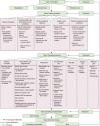A population health surveillance theory
- PMID: 23251837
- PMCID: PMC3521104
- DOI: 10.4178/epih/e2012007
A population health surveillance theory
Abstract
Objectives: Despite its extensive use, the term "Surveillance" often takes on various meanings in the scientific literature pertinent to public health and animal health. A critical appraisal of this literature also reveals ambiguities relating to the scope and necessary structural components underpinning the surveillance process. The authors hypothesized that these inconsistencies translate to real or perceived deficiencies in the conceptual framework of population health surveillance. This paper presents a population health surveillance theory framed upon an explicit conceptual system relative to health surveillance performed in human and animal populations.
Methods: The population health surveillance theory reflects the authors' system of thinking and was based on a creative process.
Results: POPULATION HEALTH SURVEILLANCE INCLUDES TWO BROAD COMPONENTS: one relating to the human organization (which includes expertise and the administrative program), and one relating to the system per se (which includes elements of design and method) and which can be viewed as a process. The population health surveillance process is made of five sequential interrelated steps: 1) a trigger or need, 2) problem formulation, 3) surveillance planning, 4) surveillance implementation, and 5) information communication and audit.
Conclusions: The population health surveillance theory provides a systematic way of understanding, organizing and evaluating the population health surveillance process.
Keywords: Animal health; Population; Public health; Surveillance concept; Surveillance theory.
Conflict of interest statement
The authors have no conflict of interest to declare for this study.
Figures
References
-
- Salman MD. Animal disease surveillance and survey systems: methods and applications. Ames: Iowa State Press; 2003. p. 4.
-
- El Allaki F. Population health surveillance theory [dissertation] Montréal: University of Montreal; 2006. p. 322.
-
- L'Abate L, Bryson CH. A theory of personality development. New York: Wiley; 1994. pp. 4–5.
-
- Moore JA. Science as a way of knowing-evolutionary biology. Am Zool. 1984;24:467–534.
-
- World Health Organization. WHO strategic action plan for pandemic influenza 2006-2007. [cited 2012 May 31]. Available from: http://www.who.int/csr/resources/publications/influenza/WHO_CDS_EPR_GIP_....
LinkOut - more resources
Full Text Sources




